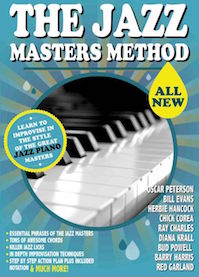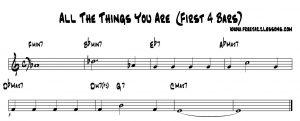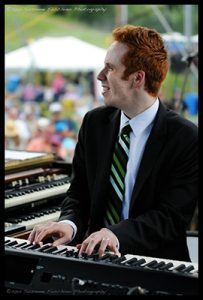Composing Music Tips: How To Write A Jazz Song
 Would you like to learn some composing music tips? You’ve come to the right place.
Would you like to learn some composing music tips? You’ve come to the right place.
In the video below, Steve teaches one of his Jazz Inner Circle students how to start writing a jazz tune.
These composing music tips are very helpful for those who are complete beginners in composition and songwriting.
Take 3 minutes and watch the video below. Steve will break down some composing music tips for you.
Composing Music Tips For Jazz Video Tutorial
5 Composing Music Tips For You To Go Deeper With Writing Jazz Tunes
Now that you’ve taken a few minutes to watch the video above, let’s go further into these composing music tips.
1. How To See The Big Picture When Writing A Jazz Tune
 The first among these composing music tips is about knowing the form of a tune.
The first among these composing music tips is about knowing the form of a tune.
Knowing the form of the tune is essential to plan out.
In music, form refers to the overall structure of the song. It tells us how a tune is organized.
We can say that form is our overall map of the song.
Many jazz tunes follow different forms. For example, it can be as brief as John Coltrane’s “Giant Steps” that has just a single 16-bar sequence being repeated over and over:
We can call the form of Giant Steps as simply “A” because it only has an “A section”.
Some tunes can have massive forms such as Pat Metheny’s “The Way Up”:
In its entirety, “The Way Up” has multiple sections spanning over an hour. You can easily imagine how many sections that tune has.
There is one important form in jazz that every player needs to know.
The Most Popular Form In Jazz: AABA
 However, the most common form we find in jazz is what we call the AABA form.
However, the most common form we find in jazz is what we call the AABA form.
We have an A section that is repeated twice, a different “B” section, and then a repeat of the A section in the end.
A good example of a song that has this kind of structure is Autumn Leaves:
The A section contains the first or main musical idea. In the case of Autumn Leaves, it’s the melody where you would sing “The falling leaves drift past my window”, etc.
The B section is a contrasting musical idea. It’s usually a different melody or theme.
Another Popular Form In Jazz: 12-Bar Blues
 The 12-bar blues form is another popularly used song form in jazz.
The 12-bar blues form is another popularly used song form in jazz.
It is essential for anyone who wants to write and play jazz to understand the 12-bar-blues form.
This is because the blues is part of the foundation for most of contemporary music, including jazz.
Here’s a good place to start learning more about 12 bar blues: 12 Bar Blues Piano Made Simple
A great example of 12-bar blues being used in jazz is the tune “Straight, No Chaser“:
The question now is how do we actually write those different musical ideas?
Let’s move on to the next few composing music tips to find out.
2. How To Start Writing A Melody
 The start of every legendary jazz tune is a singable and memorable melody. So, how do you start writing one?
The start of every legendary jazz tune is a singable and memorable melody. So, how do you start writing one?
Get to work by looking at your I chord. In most cases, you have 4 available notes to build a melody from.
While playing a I chord with your left hand, improvise a small riff out of 2 to 4 notes.
For example, check out Herbie Hancock’s “Watermelon Man”:
If you’re having a hard time getting some melodic ideas, the best way to start is with licks from the legends themselves.
 If you don’t have time to transcribe those, don’t worry as we’ve done all of that for you through the Jazz Masters Method.
If you don’t have time to transcribe those, don’t worry as we’ve done all of that for you through the Jazz Masters Method.
The Jazz Masters Method provides a step-by-step method to learn incredible jazz licks from Bud Powell, Bill Evans, Herbie Hancock, Chick Corea, Diana Krall, Oscar Peterson, Ray Charles, Barry Harris, and Red Garland.
Get instant access to the Jazz Masters Method here.
Once you’ve come up with a riff or idea, the next step is how to make it more interesting.
3. How To Use Intervallic Motion To Write Interesting Melodies
 The best song melodies don’t simply go up and down a scale or an arpeggio.
The best song melodies don’t simply go up and down a scale or an arpeggio.
Melodies should have some kind of intervallic motion.
Intervallic motion means using intervals other than whole and half steps to create a melody.
The use of intervals other than half steps and whole steps brings freshness and excitement to the melody.
Let’s look at “All The Things You Are” as an example:

As you can see in the chart above, the Ab from Fm7 moves up to a Db of the Bbm7. This is an interval of a perfect 4th.
The Ab moves back down a perfect 4th to Ab on the 4th beat of the 2nd bar then moves down just a half step to G of Eb7.
On the 3rd bar, the G just repeats in quarter notes for 4 beats and then becomes the major 7th of Abmaj7 on the 1st beat of the 4th bar.
his G them moves up to a perfect 4th (C of Abmaj7) and moves back down again a perfect 4th back to F.
Lastly, to resolve to the E of Cmaj7, the F from the G7 chord just has to move down to a half step.
3. Why Knowing The Chord Progression Helps To Write A Good Melody
 Knowing the chord progression is the best guide regarding the direction of your melody.
Knowing the chord progression is the best guide regarding the direction of your melody.
In a nutshell, good melodies consist of chord tones on strong beats that tend to resolve into each other.
These melody notes go from a point of tension to a point of release.
The chord progression of the tune will always dictate the note choices.
Let’s take a look at “All The Things You Are” once more:

If you look at the 4th beat of the 2nd bar, the Ab from Bbm7 feels like it has to resolve down to the G of Eb7.
Another instance of a nice resolution is the tension coming from F of the G7 chord resolving to the E of Cmaj7.
The way that the resolution works well is that F forms a tritone (diminished 5th) with the B of G7 and causes tension.
This tension resolves to a more pleasant sounding major 3rd formed by the E and C of the Cmaj7 chord.
Knowing how you can create tension and resolution through chord progressions will help you learn how to create those memorable melodies.
4. Why Using Fewer Notes Makes A Better Melody
 It’s no longer news when you hear the phrase, “Less is more.” Matter of fact is that it’s an oxymoron.
It’s no longer news when you hear the phrase, “Less is more.” Matter of fact is that it’s an oxymoron.
However, in terms of melodies, sometimes putting out less can have a greater effect.
More people will listen to a simple, singable melody rather than a technically difficult one with a gazillion notes.
A good melody has to have enough notes to have melodic motion. You only need a few notes, such as two notes from every chord.
“All The Things You Are” even takes this to the extreme. Some bars of the tune only have 1 melody note for an entire bar for some chords.
To sum it up, use the least possible number of notes while maintaining some melodic motion.
However, all of these composing music tips won’t do any good if you completely forget the tune you’ve just written.
5. Why You Forget What You Have Written (And What To Do About It)
 One of the biggest problems newbie jazz composers face is forgetting the ideas you come up with.
One of the biggest problems newbie jazz composers face is forgetting the ideas you come up with.
So, how do you solve that issue? Record it in a tangible medium.
Among dozens of composing music tips, this is by far one of the most important.
Recording in this sense can mean two things: transcribe your song in sheet music form or make an audio recording of it.
The fastest among these techniques is making an audio recording. It can be as simple as grabbing your smartphone and recording the audio of your performance.
You can also film yourself playing the song you just wrote.
At this point, it doesn’t matter if the song is not as good as you hope it to be. What’s important is that you capture the musical ideas first.
In case you find that your song isn’t that great. You can always work on improving it later.
Every time you come up with an idea, record it. When you can’t remember how to play it, listen to your recording.
Now that you know how to start writing a jazz tune, what’s the best way to get more ideas?
No, You Don’t Have To Jump Through Hoops To Get Great Ideas
 Do you feel like your creativity has dried up? Having trouble coming up with great improv or awesome melodies?
Do you feel like your creativity has dried up? Having trouble coming up with great improv or awesome melodies?
You may have spent a lot of time listening to the greats. However, you still fall short.
You still can’t figure out how to sound like them. You simply don’t have the time to figure it all out.
What if I told you can shorten that learning curve through the Jazz Inner Circle?
The Jazz Inner Circle provides the opportunity to work 1-on-1 with world-class jazz piano mentors.
Even if you don’t have enough time to study recordings or transcribe solos, the Jazz Inner Circle will reveal secrets that the legends use to learn great ideas in less time.
 Inside the Jazz Inner Circle, you will discover:
Inside the Jazz Inner Circle, you will discover:
- “The Jazz Piano Mastery Program” (Over $25,000 worth of jazz piano training resources, tools, practice templates, improv strategies, & tons more.)
- “The Ultimate Jazz Workout Training System.” This is where we implement a complete practice program to build your jazz piano talent in record time.
- Access to over 50 hours of high level jazz intensive workshops.
However, slots are very limited. Take the opportunity to be in the Jazz Inner Circle here.
Enjoy learning these composing music tips. If you know more tips or have any comments or suggestions, feel free to write something in the comments section below.
Remember that we’re always here to help you out in your jazz piano journey. So, go right ahead and start writing your own tunes.
